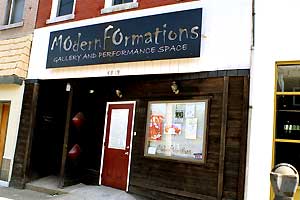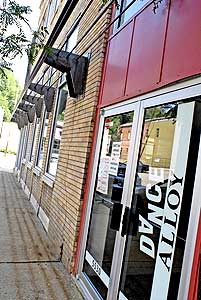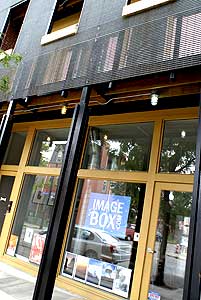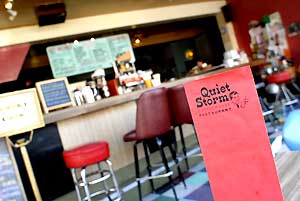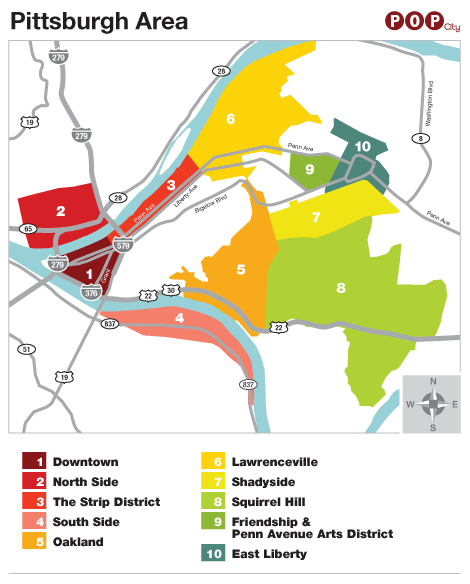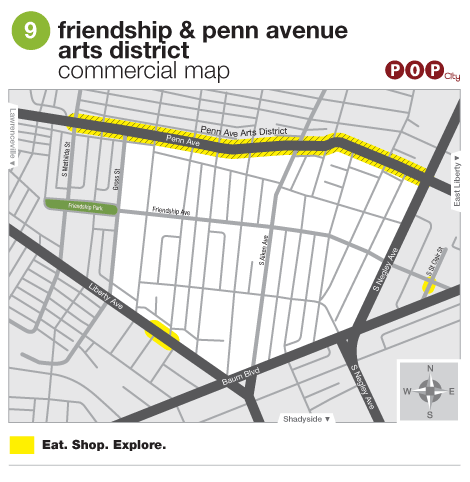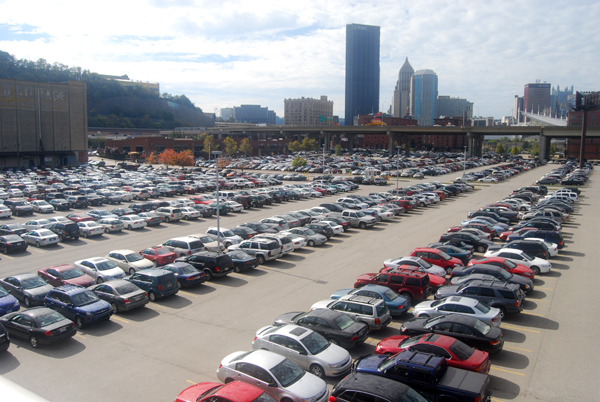
Author Archives: ryochum
-
What’s next: Authorities Plan to Revitalize Jeannette
Thursday, December 30, 2010Mayor Robert Carter said he would be “trying to do more” during his second year in office in Jeannette.
He wants to get more houses up and sold along South Sixth Street. As part of a $31 million effort to revamp the city, 25 new, single-family homes and a nine-unit townhouse complex have already been built there.
He wants to raze dilapidated facilities in the city — including the old Fourth Avenue Hotel, one of the city’s earliest landmarks; its land is slated to become a parking area.
He wants the former PNC Bank property on Clay and Fourth avenues sold — which he expects will be easier with a new parking area behind it.
And, he wants to invite visitors and make sure people know that Jeannette is “a full-service city,” he said.
“We want to make this a welcoming community,” he said.
A new Dollar General store that opened on Clay Avenue this year is proof Jeannette is still a great place to do business, he said.
“What we don’t have in manufacturing anymore, we have in stores and restaurants,” he said.
He said residents of neighboring communities still visit Jeannette to eat at The Nest, a seafood and steak restaurant on Clay Avenue, and DeNunzio’s, an Italian restaurant on Lowry Avenue.
Businesses in the industrial park will join those eateries on the city’s tax rolls next year as the tax breaks expire.
With more money being added to Jeannette’s bottom line, city clerk Michael Minyon is optimistic.
“I can feel we’re starting to turn a corner,” he said.
Council approved a $5.4 million budget this month that holds the tax rate at 32.62 mills.
One mill generates about $64,000 for the city.
Council also voted this month to raise some of its fees, a move that is expected to bring in more than $300,000 to the city, according to Mr. Minyon.
Earned income tax will be raised by 0.15 percent. Garbage fees will increase from $10.80 a month to $13.50 a month. And the mechanical device fee is doubling from $150 a year to $300 a year.
“These moves will help the city move forward,” Mr. Carter said.
But he’s mindful as he moves forward, remembering the nearly $1 million deficit accumulated in Jeannette during the last few years.
“We worked hard this year to correct mistakes of the past. We don’t want to start making them again,” he said.
— Candy Woodall
-
Golden Triangle Buildings Could Get Face-Lifts
Sunday, December 26, 2010
By Mark Belko, Pittsburgh Post-GazetteThe city is looking to brighten up some “dark corners” Downtown.
Aided by a $4 million state redevelopment assistance grant, the Urban Redevelopment Authority hopes to target rundown buildings Downtown and work with property owners to upgrade them.
The project is designed to supplement a larger revitalization in the Golden Triangle that already has included the construction of the Three PNC Plaza office tower and the redevelopment of a former five-and-dime store and a department store into residential, retail and other uses.
With much of that work completed, the URA has decided to go after properties “in need of some reinvestment” — not to buy but to approach and work with the owners about making improvements.
“This is really a building-by-building, block-by-block approach,” said Yarone Zober, URA board chairman and chief of staff to Mayor Luke Ravenstahl.
Mr. Zober said the genesis for the idea came during walks he and Mr. Ravenstahl had Downtown.
“One thing the mayor and I noticed at street level were individual buildings that needed work … or didn’t have street-level appeal. They detracted from the general feel and look of the Downtown corridor,” he said.
“It became very clear that we needed new tools to continue the revitalization of Downtown.”
Funds from the grant, awarded by Gov. Ed Rendell earlier this month, can be used to make facade improvements or to address “life safety” issues that prevent property owners from using upper floors for residences or other purposes.
Life-safety improvements could include stairwells, elevators or other measures to bring buildings up to code. URA executive director Rob Stephany said such improvements typically run $250,000 at the minimum.
While projects like Three PNC, Piatt Place and Market Square Place have helped to transform Downtown, there are other buildings still in need of work, including some near the upscale Capital Grille restaurant at Fifth Avenue and Wood Street, Mr. Stephany said.
“You go to wait for the valet to bring your car back and there’s blight staring you in the face,” he said.
Properties the city initially is targeting for possible work include the Thompson Building on Market Street between Fifth and Market Square and a building owned by the Order of Italian Sons & Daughters of America at Wood and Forbes Avenue that once housed a McDonald’s restaurant.
Also on the list are three buildings at the western corner of Fifth and Wood that house a jewelry store and other retail outlets and a couple of buildings on Wood owned by the URA itself.
Mr. Zober said the URA already has had discussions with the property owners about potential improvements.
David Kashi, owner of the Fifth and Wood properties, said he hopes to secure funds to upgrade the facades of the buildings. He plans to install new windows and perhaps add a marquee to the front of the buildings. He also is thinking about placing a “big clock” on the corner building.
“We’re going to make Downtown beautiful,” he said.
Mr. Kashi said he already has had one meeting with the URA and plans to have another next month to work out plans and budgeting. He had no estimate for the cost of improvements.
He likes the city initiative.
“Downtown is the center of the whole Pittsburgh area. I think it’s about time someone took the initiative and improved the look. Nothing has changed in 50 or more years,” he said.
Improving the overall ambiance also “attracts investors to bring money into Downtown Pittsburgh,” he said.
The program will require property owners to match amounts received from the URA. Mr. Kashi is not thrilled about having to do so but said he would to increase the value and curb appeal of his properties.
The Thompson Building, which once housed the Ciao Baby restaurant, is owned by the Pittsburgh History & Landmarks Foundation, which already has redeveloped three adjoining buildings at Market Street and Fifth.
Arthur Ziegler Jr., president of the foundation, said the organization plans to restore the facade of the Thompson Building, which likely will play host to some type of restaurant, bar or cafe.
Mr. Ziegler said the building once housed a restaurant operated by the Chicago-based Thompson restaurant chain. The chain at one time had six restaurants in Pittsburgh, but the Market Square building is the only one that has survived.
It was purchased by John R. Thompson in 1926, but dates back farther than that, perhaps to the turn of the century.
“It is an important part of Pittsburgh history,” Mr. Ziegler said.
Besides restoring the exterior, the foundation will “try to meet the green standards that we’ve established down there and we want to get the building in service as soon as possible in 2011,” he said.
The foundation spent $3 million restoring the original facades of the three adjoining buildings, which house a men’s clothing store, a shoe store and apartments. It plans to make a substantial investment in the Thompson Building but also is looking for help from the URA to fill in the gap.
“We did not do that with the first three buildings. We provided the funds. We need some help with this fourth one,” Mr. Ziegler said.
Like Mr. Kashi, Mr. Ziegler believes there is a need for the type of program the URA is starting.
“I think it’s excellent. We need to continue to recognize the value of these historic buildings and improve their exteriors and their basic interiors to meet building codes,” he said.
At the site of the former McDonald’s restaurant, the city would like to remove the burnt-orange metal facade that covers the upper floors and restore the building’s original exterior.
Mr. Ziegler said that underneath the current facade the building features an attractive stone architecture. “It was a handsome corner and we would like to see it be that again,” he said.
Officials at the Order of Italian Sons and Daughters could not be reached for comment.
While the URA has targeted some real estate, any Downtown building owner interested in upgrading a property can contact the agency about possible aid, Mr. Zober said.
The city’s effort is unrelated to six acquisitions totaling $15.15 million made by an unidentified buyer on the east side of a block bordered by Wood, Fifth and Forbes over the past eight months.
While the identity of the buyer is not known, many in the real estate community believe it is PNC Financial Services Group, which built Three PNC Plaza. A PNC spokesman has said, “We don’t comment on speculation.”
There’s much talk that the block could be the site of the next big development Downtown. In the meantime, the city is hoping to fill in the cracks.
“Our goal is to really make Downtown look complete,” Mr. Zober said.
-
Collier to Preserve Historic Photographs
Thursday, December 23, 2010
By Carole Gilbert BrownThe decision by Collier commissioners to spend $1,134.20 to scan and frame historical township photographs is an award winner for Gene Czambel, 67, of Steen Hollow Road.
Mr. Czambel, a lifelong resident who traces his family’s roots in Collier back to 1882, has been on a crusade for several years to preserve the township’s history through photographs and other memorabilia.
He has offered 16 photos from the Beechmont area and beyond to be scanned and framed so that residents can view them in the township building and the Nike Site property. Many date back to the early 20th century and late 19th century.
If the township forms a historical society, he promises to donate the originals, as well as about 30 more historical photographs.
“I have a museum here between my dad, grandfather and great-grandfather,” he said.
But, with no descendants, he adds, “When I’m gone, it’s gone.”
Among the approximately 50 photos are shots of the Pittsburgh Coal Co.’s Essen No. 2 Mine in Burdine, a photograph of the now-gone Beechmont School with his mother shown, too, as well as pictures of the former town of Hickman, which was named after farmer Joseph Hickman but developed by Mr. Czambel’s great-grandfather, who was an engineer and entrepreneur.
Burdine, Beechmont and Hickman have been incorporated into what is now Collier.
The town burned down in a fire, but included at one time a post office, store, and a hotel with a bar. Mr. Czambel even has photographs of the fire.
Mr. Czambel has donated photographs to other area communities, too, including Bridgeville, Carnegie and Oakdale.
Besides photographs, he possesses historical memorabilia, too. For example, the cement pads that once were in front of the boys’ and girls’ outhouses at Beechmont School are now in his front yard.
Anyone interested in donating historical photographs or memorabilia, or in helping to form a historical society, should contact the township.
-
Blast From the Past: Old Steel Mill Forges New Life as a Park
Ben Muessig
AOL News(Dec. 2) — Preservationists outside Pittsburgh are fighting to put an abandoned steel mill back to work — not so it can produce metal, but so it can protect history.
Since the blast furnaces fired up for the last time at the Carrie Furnace in 1978, the decaying steel mill on the bank of the Monongahela River has served as a solemn reminder of the industry that turned Pittsburgh into a thriving city — then left it polluted and jobless.
Now, more than three decades after the Carrie Furnace went from being a bustling workplace for 4,000 employees to a 168-acre ghost town, a team of preservationists is trying to convert the remains of the hulking factory in Rankin, Pa., into a museum dedicated to the region’s steel history.
“Pittsburgh is known for steel,” said Sherris Moreira, a spokeswoman for Rivers of Steel Heritage Corp., the group spearheading the preservation project. “There is this pride that people here have for their steel heritage — and this is a tangible way for people to connect with that history.”
Rivers of Steel hopes to preserve the remaining structures, transforming the industrial ruin into an interactive historical center inside a park.
At the heart of the proposed preservation project are the two remaining blast furnaces, which were built in 1907 and left largely unchanged until U.S. Steel halted operations at the Carrie Furnace.
The massive ovens are rare examples of pre-World War II steel-making technology — and they could make the perfect centerpiece for the proposed museum, according to Rivers of Steel curator of collections Tiffani Emig.
“They were never invested in for improvements and they were never upgraded. Everything was done by hand up until the day it closed,” Emig said. “That’s what makes them special.”
Those industrial relics — along with five other furnaces that were demolished — manufactured as much as 1,200 tons of iron per day, creating metals used in the construction of the Empire State Building and St. Louis’ Gateway Arch.
When the blast furnaces were operational, they turned ore, coke and limestone flux into a molten metal that was transported by rail across the aptly named “Hot Metal Bridge” to U.S. Steel’s Homestead Works, where it was converted into steel.
The Homestead Works were razed in 1988 and the site was converted into a shopping mall in 1999. Today, all that remains of the historic steel mill are the smokestacks, which tower over a movie theater parking lot across the river from the Carrie Furnace.
The Carrie Furnace has already been deemed a National Historic Landmark, meaning it likely won’t meet the same fate as the Homestead Works. But that doesn’t mean the site isn’t in danger.
When industry moved out, nature moved in. Tree roots have undermined the stability of some Carrie Furnace buildings, and grapevines scale the superstructure of the sprawling mill. Foxes, hawks and deer have recently been spotted on the site — and they’re not the only new visitors.
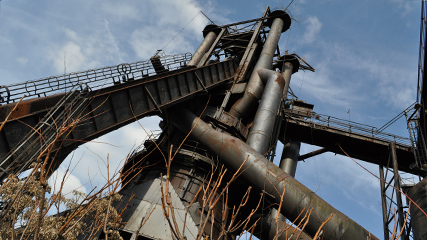
Since U.S. Steel halted operations at the Carrie Furnace in 1978, nature moved in. Trees tangle their way through the plant, and grapevines crisscross the catwalks. Ben Muessig for AOL News
The abandoned steel mill has become a destination for graffiti artists, paintball players, vagrants and vandals who strip the site and sell the stolen scrap metal.
“The wiring and anything else that can be scrapped has been taken out,” said Emig, who told AOL News she’s often chased away uninvited visitors. “With the graffiti, the paint wears off. It’s the people who are physically stripping the site who are the problem.”
Rivers of Steel plans to restore some parts of the Carrie Furnace to look the way they did when the plant was operational. But other parts — like a massive sculpture of a deer head built from metal and wire in the 1990s by the Industrial Arts Co-Op — will remain as they are today.
“We will preserve some of the graffiti, definitely the deer,” Emig said. “This site didn’t die in 1978. This place continued to be used, and we want to show that.”
Even if Rivers of Steel gets its wish and is able to preserve the remaining steel mill structures, the rest of the 168-acre property could look very different in the coming years. Allegheny County owns the entire site and began renting the Carrie Furnace buildings to Rivers of Steel in May.
County officials are looking for builders interested in bringing light manufacturing and residential development to the rest of the grassy plot.
New businesses or homes near the old steel mill will certainly change the site’s context, but they won’t compromise the Carrie Furnace as a historic site, according to Emig.
“It’s already compromised,” she said. “There’s only two furnaces left; there used to be seven. You work with what you have.”
The most important thing the Carrie Furnace has is its historic site, according to Arthur Ziegler, president of the Pittsburgh History and Landmarks Foundation.
“We have saved artifacts from the mills — blowing engines, a Bessemer converter and so forth — but we had to relocate them,” Ziegler said. “But this will be the first time it’s all preserved on site.”
Obviously, making the dilapidated steel mill a safe destination for sightseers isn’t going to be easy — or cheap.
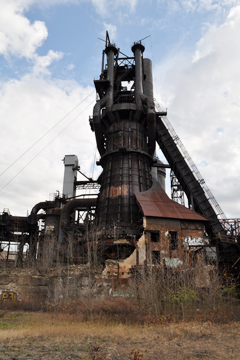
Turning the decaying steel mill into a park and history center won't be cheap -- but preservationists say residents of the "Steel City" are rallying behind their plan. Ben Muessig for AOL News
The group’s “bare-bones cost estimate” for the project is $78 million. Current funding only allows for repairs of a severely damaged roof at one of the powerhouses.
To fund other projects, like securing shaky catwalks, clearing out tons of debris from the mill’s stock house, or perhaps building a monorail like the one depicted in flashy conceptual images of the historic center, the group will seek public funding and private donations.
There’s talk of approaching the National Parks Service for help, but it’s unclear whether the cash-strapped agency would be interested in or able to offer assistance.
Though finances are a concern, Moreira says she’s been encouraged by the interest in the project.
“Heritage matters,” said Moreira, whose group has given tours of the Carrie Furnace to more than 700 eager visitors in the past two months. “It’s not only important to know where we come from, but it’s important looking to the future.”
In the years since the steel industry left Pittsburgh, the “Steel City” has in many ways attempted to distance itself from its metal-producing past. But the city’s industrial legacy lives on — and not just in the name of its football team and local beer.
According to Moreira, many Pittsburghers have started looking to the city’s steel-making roots as a source of pride.
“There was a lot of bitterness when the steel went away. People wanted to move on. But now people are at the point where they want to look back,” she said.
“This isn’t just steel; it’s about emotions.”
-
Washington County Farm on Statewide Danger List
Monday, December 20, 2010By Len Barcousky, Pittsburgh Post-GazetteA Washington County farm that has been operated by the same family for more than 200 years has been included on a list of 10 historic sites most at risk across Pennsylvania.
Longwall coal mining could harm several historic buildings at Plantation Plenty in Independence Township, according to Preservation Pennsylvania. The nonprofit organization released its list of endangered properties on Thursday.
State and federal environmental and preservation regulations require an analysis of the impact of commercial activities like mining on historic properties, according to Erin Hammerstedt, a field representative for Preservation Pennsylvania and the National Trust for Historic Preservation.
“Our goal would be to keep longwall mining out of this historic farm,” she said.
Preservation Pennsylvania is a private membership organization that seeks to protect historically and architecturally significant properties. The National Trust for Historic Preservation, created by Congress in 1949, plays a similar role across the country.
Plantation Plenty has been operated since 1800 by Isaac Manchester and his descendants. Joseph Pagliarulo and his wife, Margie, who is a Manchester descendant, acquired the 400 acres in 2005 and now run it as an organic farm, producing milk, beef, pork and vegetables.
The Manchester family had sold coal rights to the property in 1915, except for three acres under the farmhouse and other nearby buildings. The mining rights are owned by Penn Ridge Coal, a subsidiary of Alliance Resource Partners, a Tulsa, Okla.-based coal producer with $1.2 billion in revenues.
While longwall mining would never occur directly under the farmstead, major mine subsidence nearby still could damage the structures, Ms. Hammerstedt said. Another possible side-effect of the mining could be to degrade or ruin the farm’s water supply by fracturing the rock that feeds its springs and wells, according to Preservation Pennsylvania.
Penn Ridge has not yet applied for mining permits, Mr. Pagliarulo said, but he fears “it is just a matter of time.” He said it is not financially possible for him and his wife to buy back the coal rights.
An end to farming on the Manchester property would represent a cultural and environmental loss, he said.
“This property has been in my wife’s family for more than 200 years,” he said. “A visit here lets you step back in time … and see how 18th and 19th century farming took place.”
Two other Western Pennsylvania properties or areas are on the preservation organization’s list.
Holland Hall in Meadville, which has been vacant for 15 years, is in danger of demolition, according to Preservation Pennsylvania. The poor condition of the building — many interior walls and electrical, plumbing and heating mixtures have been removed — make it attractive to a buyer who would tear it down and replace it with a new structure.
Holland Hall was built in 1899 by A.C. Huidekoper, a Civil War veteran who made fortunes in coal, iron, oil and railroad businesses. The Gilded Age mansion was built around a smaller red-brick building constructed in 1804. Mr. Huidekoper and his wife, Frances, had lived in the smaller structure before the larger house was built.
Following the death of Mrs. Huidekoper, Holland Hall was sold and used as a fraternity house from 1935 to 1995. Plans to redevelop it as a conference center and bed-and-breakfast fell through.
“In order to prevent the demolition or continued neglect of Holland Hall, a buyer interested in acquiring and rehabilitating this architecturally significant building is needed,” according to “Pennsylvania at Risk 2010,” the organization’s newsletter.
Plans for a wind farm on the crest of Evitts Mountain in Bedford County’s Bedford Township could endanger a rural historic district known as Dutch Corner, according to Preservation Pennsylvania.
Dutch Corner has more than 30 farmsteads and a historic school, church and several cemeteries.
Plans to build 24 wind turbines on the ridge above the valley would require blasting and filling to construct concrete foundation pads and to bury a transmission cable, according to the organization. It also warns that noise from the wind turbines would disturb the neighborhood’s rural character while the blasting could affect water supplies.
Preservation Pennsylvania does not oppose either longwall mining or wind farms in general, Ms. Hammerstedt said. “There are places where these activities are a good thing,” she said. “But there are other areas where these projects are not appropriate, because they would endanger historic buildings or landscape features.”
Preservation Pennsylvania’s 2010 list of at-risk sites is available on its Web site, www.preservationpa.org.
-
PENNSYLVANIA AT RISK 2010 ANNOUNCED
December 16, 2010
PENNSYLVANIA AT RISK 2010 ANNOUNCED
Preservation Pennsylvania announces the annual listing of the Commonwealth’s most endangered historic resources.Preservation Pennsylvania, a statewide non-profit historic preservation group, released its annual Pennsylvania At Risk list today, which highlights 11 endangered resources.
Pennsylvania At Risk serves as a representative sampling of the Commonwealth’s most endangered historic resources. For the purpose of the list, endangerment is defined as threat of demolition, significant deterioration, vandalism, alteration, and/or loss of its historic setting. It is Preservation Pennsylvania’s belief that publishing this list draws statewide attention to the plight of Pennsylvania’s historic resources, promotes local action to protect resources, and encourages additional state funding for historic sites.
Resources included on the Pennsylvania At Risk 2010 list include:
East Stroudsburg Railroad Station (East Stroudsburg, Monroe County)
Built in 1864 as the Stroudsburg station on the Delaware, Lackawanna and Western Railroad, the East Stroudsburg Railroad Station is a landmark in the community. The depot’s presence led to rapid commercial growth, establishing Crystal Street as the business hub of a rapidly expanding community. Thanks to the efforts of East Stroudsburg’s residents and supporters, and the partnerships between community groups, non-profits, private corporations and individuals and the borough, the building was saved earlier this year after demolition of the station had begun. However, initial funding to save the 1883 building only covers partial reconstruction and restoration, so efforts to secure the long-term future of the station will need to continue.U.S.S. Olympia (Philadelphia, Philadelphia County)
Built by the United Iron Works of San Francisco in 1890-1893 and commissioned in 1895, the cruiser U.S.S. Olympia is a National Historic Landmark that represents critical points in American history. She served as the flagship of the Asiatic Squadron in the Spanish-American War, and it was from the Olympia’s bridge on May 1, 1898 during the Battle of Manila that
Commodore George Dewey issued the famous command: “You may fire when you are ready, Gridley.” Its final mission was bringing home the body of World War I’s Unknown Soldier fromFrance in 1921. It was decommissioned in 1922, then opened as a museum in 1958. Since taking ownership of the ship in 1996, the Independence Seaport Museum in Philadelphia has spent $5.5 million on repairs, inspections and maintenance of the Olympia; yet, without major a refurbishment and plans for its future use/preservation, the Olympia will either sink at its moorings, be sold for scrap, or be scuttled for an artificial reef off Cape May, New Jersey. While efforts to secure private or public funding for the project have been unsuccessful to date, the National Park Service has begun working with stakeholders to seek a positive preservation outcome. The U.S.S. Olympia was scheduled to close to the public November 22, 2010. However, it was recently announced that she will remain open until January.
Schuylkill School (Schuylkill Township, Chester County)
Schuylkill School was built in 1930 and brought children together from a number of area one- and two-room schoolhouses. Construction of the school was made possible through the philanthropy of Frank B. Foster, who helped fund three consolidated schools in Chester County (the other two of which are still in use). In 2002, the Schuylkill School was determined eligible for inclusion in the National Register of Historic Places; that same year the Phoenixville Area School District began to consider the school’s demolition. Despite studies that have identified several potential new uses for the building, the Phoenixville Area School District plans to begin demolishing the building in December 2010. The ground where the historic school now stands will become a parking lot.Stewartstown Railroad (Stewartstown to New Freedom, York County)
From 1884 to 1972, the Stewartstown Railroad connected farmers and manufacturers to markets in Baltimore. The Stewartstown Railroad remains in business under its original charter of 1884–the only such operation in existence that did not merge with another railroad or was subjected to any form of corporate reorganization. Seven railroad structures along the 7.4-mile line have been listed in the National Register of Historic Places and the line itself has been determined eligible for inclusion in the National Register. The financial generosity of George Hart, President of the Stewartstown Railroad, kept the company operational through recent tough times; however, this resulted in a substantial lien against the railroad. Arrangements to forgive the $352,000 sum were not made in Mr. Hart’s estate plans as expected. Now, unless the Bucks County Historical Society, beneficiary of Mr. Hart’s estate, will agree to defer payment of the lien for several years, the Stewartstown Railroad would be forced to liquidate its assets to raise the $352,000 that it owes.Holland Hall “Huidekoper Mansion” (Meadville, Crawford County) Holland Hall was built by Arthur Clark (A.C.) Huidekoper in 1899 and it survives as Meadville’s only Gilded Age mansion. Holland Hall is currently threatened with demolition. Following the death of Frances Reynolds Huidekoper in 1932, Holland Hall was occupied by Allegheny College’s Phi Delta Theta fraternity who occupied it from 1935 until 1995. It was then sold and has remained vacant for fifteen years. In order to prevent the demolition or continued neglect of Holland Hall, a buyer interested in acquiring and rehabilitating this architecturally significant building is needed.
“Plantation Plenty” Isaac Manchester Farm (Avella, Independence Township, Washington County) Plantation Plenty is a farm of just over 400 acres that has been owned and occupied by the members of the Manchester family for 210 years. The house, completed by Isaac Manchester in 1815, is one of the finest examples of Georgian architecture in Western Pennsylvania. The property is currently operating as a multi-faceted organic farm, producing milk, beef, pork, eggs and a variety of fruits and vegetables. While much of the significance of Plantation Plenty is clearly visible through its buildings, it also contains potentially important prehistoric and historic archaeological sites. Despite the property’s importance, it is now threatened by longwall mining. Subsidence caused by longwall mining under the farm, which causes the ground to drop between 4 and 6 feet at the surface, may cause severe damage to the historic buildings, and will fracture the rock that forms springs and wells which may alter or eliminate them. In addition, a large ventilation shaft is proposed immediately adjacent to the 3-acre protected farmstead. This would be a visual intrusion on the historic farm, and would alter the farm’s setting by introducing noise inappropriate to the quiet, agrarian landscape.
122-124 and 126 West Miner Street (West Chester, Chester County)
The National Register listed West Chester Historic District (Boundary Increase) is locally significant as a governmental and commercial center that reflects period architectural styles and the community’s development. Residential structures built circa 1844 and 1837, respectively, the buildings at 122-124 and 126 West Miner Street in West Chester are contributing elements to the West Chester Historic District. Both buildings are currently threatened with demolition. They are owned by the adjacent First Presbyterian Church, which proposes to tear them down to make room for additional facilities. The current proposal is a complete reversal from the Church’s originally presented plan which incorporated the two buildings into the expanded facility. The demolition of these two historic buildings will result in a significant loss of the community’s historic fabric and will erode the historic character of the larger community.Laverock Hill “Sims” Estate (Cheltenham & Springfield Townships, Montgomery County)
One of the last intact Gilded Age country estates in Montgomery County, the centerpiece of the Laverock Hill Estate is an 11,000 square foot residence created in a neo-Georgian style. The 42-acre property also includes a 19th century stone dwelling, the farm’s original horse and cattle barn, the former dairy barn (now a residence), and four additional dwellings. The Laverock Hill mansion has been vacant for nearly three years, as have the stable, carriage house and greenhouse. In early 2008, Hansen Properties, LLC acquired the 42-acre tract, and proposed a development that would include 216 residential units targeted for sale/rental to adults age 55 and over. No plans have been submitted yet for the portion of the property in Springfield Township, but the developer has expressed an interest in building at least 120 cluster housing units with requisite parking, roads and utilities on that portion of the estate. The property has been determined eligible for inclusion in the National Register of Historic Places, however, it is not located in a local historic district that is regulated by a historic preservation ordinance. In an attempt to preserve the site, over 150 neighboring families have informally organized into a group called Save Laverock Hill. Their goal is to have the current permit application denied, and to work to find an alternative plan for the use of the property.Dutch Corner Rural Historic District (Bedford Township, Bedford County)
The Dutch Corner Rural Historic District includes over 30 historic farmsteads as well as a church, a school and multiple cemeteries. Evitts Mountain is a dominant natural feature that clearly forms the physical, visual and legal edge of the Dutch Corner district. Atlantic Wind, LLC, a subsidiary of Iberdrola Renewables, proposes to develop 24 40-story wind turbines in a chain along the top of Evitts Mountain, surrounding Dutch Corner on two sides. The development will involve removal of trees from the mountain, as well as blasting and bulldozing rock then pulverizing it for use as fill to flatten the mountain top for the turbine pads, access road and cable trench. In addition to reshaping the mountain, the blasting will fracture the bedrock and disrupt the flow of groundwater to the area. Operation of the wind turbines will result in a noise increase of 15 to 20 dBA, replacing the natural sounds of a rural community with constant noise. This development will result in drastic changes to the Dutch Corner Rural Historic District, and will severely compromise qualities of the district that contribute to its significance.Eagles Mere Historic District (Eagles Mere, Sullivan County)
Eagles Mere Historic District is an intact turn-of-the-century resort community consisting of cottages, boat houses, commercial buildings, churches and outbuildings situated around a natural spring-fed lake 2,100 feet above sea level in the Allegheny Mountains. The district also includes Eagles Mere Beach, hiking trails, pristine wooded areas, and is surrounded by thousands of acres of forest. Since its establishment in the 1880s, people have been working to preserve Eagles Mere as a secluded retreat for visitors and residents. However, the setting of this historic district is currently threatened by natural gas extraction from Marcellus shale. Unlike many places whose economy could benefit from natural gas extraction, if the District’s water supply/quality is damaged, its beautiful setting is altered, or the peaceful, secluded nature of the area is disrupted by increased truck traffic and the operation of heavy equipment, those very features that make Eagles Mere attractive and economically viable will be lost.
Neuweiler Brewery (Allentown, Lehigh County)
Construction of this large brewery began in 1911 and the facility opened in 1913 producing traditional German style beers. Designed by architects Peuckert and Wunder to satisfy the demands of owner Louis F. Neuweiler, the brewery was more elaborately adorned than most industrial facilities of its day. The company closed its doors in 1968, and the site has remained mostly vacant since then. Underutilization of the buildings has led to their neglect and deterioration, which threaten the resource’s survival. The Redevelopment Authority of the City of Allentown (RACA) now owns the property. Recognizing its significance, they have conducted a study that shows that the vast majority of the complex is still structurally sounds. RACA is taking initial steps to facilitate rehabilitation of the brewery, but a developer will be needed to complete the rehabilitation and put the building back in use to prevent further deterioration or the need for demolition.
Updates on Previously Listed Properties
The Pennsylvania At Risk list also includes updates on previously listed properties. Articles about the J. W. Cooper High School Shenandoah, Schuylkill County (PA At Risk 2001); Saylor Cement Kilns Coplay, Lehigh County (PA At Risk 2005); and Church of the Assumption on Spring Garden Street, Philadelphia (PA At Risk 2009) are featured in the 2010 issue. For additional information on updates, please see the attached link for the Pennsylvania At Risk publication or contact Preservation Pennsylvania at 717-234-2310.
The Pennsylvania At Risk 2010 list is released in partnership with the Pennsylvania Historical and Museum Committee (www.phmc.state.pa.us). Preservation Pennsylvania is a statewide, not-for-profit, educational and advocacy historic preservation organization and serves as a statewide voice on historic preservation issues. For more information, visit the website at www.preservationpa.org or contact Preservation Pennsylvania at 717-234-2310.
-
The Visitor’s Guide to Friendship
Pop City MediaKelli McElhinny | Wednesday, September 13, 2006If you haven’t been to Friendship’s northern border of Penn Avenue lately, you’re in for a sweet surprise. The transformation, from a blighted area to a vibrant arts district, is well underway, courtesy of the Penn Avenue Arts Initiative (PAAI), a strategic partnership between the Friendship Development Associates and Bloomfield-Garfield Corporation. Today, many of Pittsburgh’s best-kept secrets, from art to architecture, can be found in Friendship.
The gutsy transformation has been driven by the PAAI, a formidable group which helps artists buy and renovate properties, provides technical assistance to artists, and promotes them as well as the neighborhood. The group even connects artists to local youth and their families through fun events and workshops that benefit all involved.
The liveliest time to visit this vibrant neighborhood is the first Friday of each month, for the PAAI showcase, Unblurred, when the area’s galleries and businesses throw open their doors to host a variety of events, from openings to art workshops. Despite gloomy weather and the threat of rain at the September event, music filled the air and hundreds of people jammed the galleries in the festive gathering on Penn Ave.
Mural Mural on the Wall
As you work your way down the street (Penn Ave, that is) keep on eye on the building walls of Friendship where some of the neighborhood’s most intriguing public art –such as the well-known The Bride Mural—can be found.
The landmark Bridal Mural, designed and created by the late Judy Penzer and Jill Watson, fools the eye by depicting a continuation of the row of buildings next to it. In 2001, “The Gateway,” mural was created by local artists at 5149 and 5150 Penn Avenue to represent the mission of PAAI – bringing the arts on both sides of Penn Avenue together via the street itself. Another notable mural is at 4908 Penn Avenue. Titled “Today’s Heroic Paragon,” it was created by Kevin Fung in 2003 in memory of a resident.
Many of the murals are the product of the Sprout Fund, a much-admired foundation located in Friendship that funds arts and other area projects that enliven the city as well as stimulate economic development by making the region attractive to young people.
The Art of Dance. And Foursquare.
The eastern end of Penn Avenue in Friendship is home to Attack Theater, one of Pittsburgh’s most innovative performing arts groups. In studio space at the corner of Penn and Mathilda, the dance troupe holds occasional informal performances in addition to offering modern dance classes to the community on Tuesdays. Unblurred attendees wanting to nurture their inner child can stop by for Game Night, to play foursquare, 3D tic-tac-toe, and Connect Four, and enjoy intermittent performances.
Further along Penn Avenue, you’ll find a group of modest galleries where hipsters – with a few adventurous suburbanites mixed in – spill out onto the sidewalk. Visitors to Modern Formations can settle into one of the comfy couches to enjoy a performance by local musicians, or peruse the pieces by Pittsburgh artists that grace the gallery’s purple walls.
Next up is Garfield Artworks, which shows local, regional and national artists, features a 100-foot-deep floor plan that lends itself to a multitude of uses, from performances to poetry readings to private parties.
At this point in the trip down Penn, a quick detour down Winebiddle Street is worthwhile to see the Waldorf School of Pittsburgh, located in one of the neighborhood’s oldest and most beautiful buildings. Originally a private residence that was converted into a convent for sisters of the Ursuline order, the building now houses the private K-8 school that moved to Friendship from the South Side in 2003. This historic landmark still hosts private events, in addition to its everyday function.
Back on Penn Avenue, head for the Clay Penn, with its storefront graced with thousands of mosaic tiles, many designed by Unblurred participants in a workshop. Owner and artist Laura Jean McLaughlin showcases her own work in the first-floor space, along with exhibitions by other artists. Soon, community classes and workshops will be offered here, too.
Next stop? Studio 5013 where, at any time, you can view a window display of one of many local artists since it’s illuminated for nighttime browsing. Behind the gallery curtain, artist Laura Shaffalo has done a tremendous job restoring the building’s splendor in creating her own live/work space, refinishing the building’s original pine floors and preserving architectural features such as the French doors.
There’s still room for improvement but The Penn Avenue Arts District continues to blossom and grow with each passing month. Since July, Penn Avenue has seen the opening of four additional galleries: IMAGEBOX at 4933 Penn Avenue, < c > space at 4823 Penn, ON Gallery at 5005 Penn and 5151 Penn Gallery.
At < c > space, a live band entertained a throng of visitors during its opening event September 1st. Guests were treated to art and music on the first floor, along with an appetizing spread of food and drinks, while upstairs the hip, renovated living quarters were open for viewing.
On September 14th, ON Gallery plays host to noted author, Mary Gaitskill, in a Pittsburgh Arts & Lectures event.
Wine and dine
Hungry? You’re in a great spot for some of the city’s best offerings in ethnic fare. Although the selection is small, the cuisine is top-notch. The locals swear by the curry at People’s Indian Restaurant, and Pho Minh is one of Pittsburgh’s few spots for authentic Vietnamese. Those with less exotic tastes can grab a slice with just the right amount of grease without parting with too much dough at Vince’s Pizza or Calabria’s.
A little farther up the street, past two institutions found in nearly every urban neighborhood – the dollar store and the funeral home – lies one of Penn Avenue’s most eclectic spots, the Quiet Storm. Complete with a vegan-friendly menu, an abundance of toys for folks under 10 (and ample space in which to play with them), and a magazine selection that puts the corner newsstand to shame, this nuisance bar-turned-coffeehouse draws in a mélange of characters from all over the city, whether a family stopping in for Sunday brunch or a doctoral student hunkering down to work on his thesis. The menu alone makes the Quiet Storm a must to visit, but those who need extra motivation might find it in the live performances hosted by the coffeehouse on Friday and Saturday nights.
Another option within walking distance is Silky’s Pub, a cozy Liberty Avenue bar that gives patrons the opportunity to brush up on their shuffleboard skills while sipping a beverage. At the end of Friendship Avenue, the popular Sharp Edge features such an extensive collection of Belgian beers that the owner has been knighted in Belgium.
Across the street from the Quiet Storm is the highly regarded EDGE studio, a cutting-edge architecture firm that regularly brings artists of international stature regularly into their gallery.
Reaching the eastern end of Penn Avenue, you’ll find one of the nation’s best glass facilities, and possibly in a class by itself, the Pittsburgh Glass Center. Housing large studios in space that formerly served as a car showroom, PGC is known across the country for the quality of art it produces–American Style magazine recently noted that it put Pittsburgh on the map for glass– and the community is encouraged to participate in the process. The facilities are impressive: eight glory-holes, a flame-working and a cold-working studio, natural gas and propane hand-torches and a roomy gallery to display the stunning glass work creations. A variety of classes you won’t find elsewhere are offered by masters in their art form, from glassblowing to bead making, and participants of all skill levels can find a course that fits their experience.
More classes of a different variety can be found just down the street from the PGC. The Neighborhood Dance Center, home to Dance Alloy Theater, provides space for one of the region’s most comprehensive community dance and fitness programs as well as their own professional modern dance company. Courses grouped by age allow a range of participants from toddlers to grandmas to enjoy activities from ballet to tango to Pilates. There’s no better place in Pittsburgh to get moving – and meet new friends. The company performs on a biannual home season with smaller showings throughout the year.
How to get there
What’s the best way is to get to this evolving neighborhood? Public transportation choices are plentiful. Eight PAT routes travel through one of Friendship’s main thoroughfares. If you choose to come by car, street parking is almost always available as well, if not on Penn, then no more than two blocks away on one of the cross streets.
Here are the main PAT routes to get you around the neighborhood.
Baum Boulevard: 77A, 77B
Centre Avenue to Downtown: 71A via Oakland, 81B via the Hill District and 86A via Bloomfield and the Strip District
Friendship Avenue to Downtown and East End destinations (such as Highland Park, the Pittsburgh Zoo and Morningside): 77D, 77F and 77GPenn Avenue: 86B to the Strip District and Downtown, 89A to the East Liberty shopping district and Martin Luther King, Jr. East Busway
Routes 77A, 77B, 81B, 86A and 86B also serve East Liberty shopping areas.While the first Friday of the month is when Friendship is showcased at its finest, anytime is a good time to visit this up and coming neighborhood.
-
Buncher Co. to Redevelop Terminal Produce Building and Build on Unused Riverfront Land
Pop City Media
Wednesday, December 15, 2010
The Urban Redevelopment Authority has agreed to lease–with an option to sell–the 130,000-square-foot Fruit Auction Terminal Produce Building on Smallman Street in the Strip District. The Buncher Co. plans to turn the building into a thriving commercial space.
To purchase the building, Buncher must commit to building 75-units of residential housing on the 55-acres of surface parking behind the Terminal Building. The firm must also promise to preserve the historic architecture.
“The building really is at the end of its useful life. It needs anywhere from $6 to $10 million in capital improvements to bring it up to code and preserve it,” says Rob Stephany, executive director of the URA.
According to Stephany, Buncher is about 20% of the way into their planning process, having selected the renowned historic preservation architect Albert Feloni to create a master plan for the Terminal Building. Astorino is under contract to do the master plan for the vacant surface parking along the river between the convention center and 41st Street.
Once Buncher submits the master plans to the URA for review, the gears of construction can really start turning. Stephany says a recently conducted market analysis indicates the building would best benefit from restaurants, office, and showroom spaces on the platform, citing the Society for Contemporary Craft and The Pittsburgh Public Market as examples of forward-thinking reuse of these kinds of buildings.
As part of the project, the URA and the City recently rezoned part of the Strip as a redevelopment area, causing concern from some neighborhood stakeholders who thought the URA might be preparing for eminent domain seizures. Stephany says that while this is certainly not the case, they didn’t do a good of a job in communicating their plans. Their intent was to make funds from investors more flexible.
Sign up to receive Pop City each week.
Writer: John Farley
Source: Rob Stephany, URA
Photograph copyright Brian Cohen



